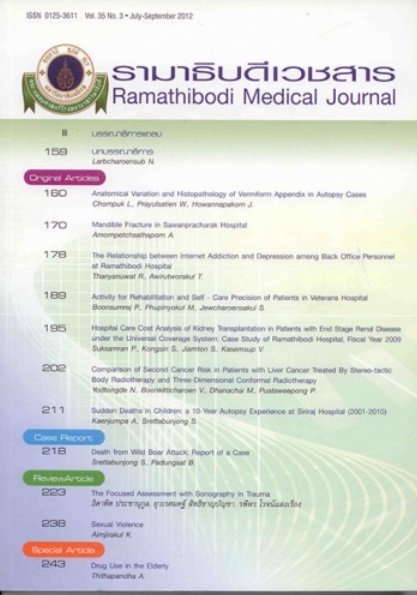Anatomical Variation and Histopathology of Vermiform Appendix in Autopsy Cases
Main Article Content
Abstract
“Anatomical variation and histopathology of vermiform appendix in autopsy cases” is interesting review of anatomy of vermiform appendix of a group of near normal population of 357 Thais as well as nice summary for statistically studying. The study done at Faculty of Medicine, Narasuan University, Phitsanulok, which is a province (changwat) located in the lower part of the North of Thailand.
The vermiform appendix is a blind intestinal diverticulum, arises from the posteromedial aspect of the caecum of the midgut. The position of the vermiform appendix is variable, but it is usually retrocaecal (8 - 67.3%), followed by pelvic or descending (12 - 43.6%), subcasecal (1 - 19%), per-ileal (1 - 4.9%), post-ileal (0.5 - 37.25%), retrocolic (0 - 12%), paracaecal (0 – 11.7%), paracolic and promonteric type. In unusual cases of gastrointestinal malrotation, the vermiform appendix may locate in the right hypochondriac (with sub-hepatic caecum) and left abdominal regions. However, pelvic type is more common than retroceacal type in some population such as German people and this study (79.3%). Moreover, the post-ileal type (37.25%) is the most common location of vermiform appendix in the Northeast Thailand cadavers. The vermiform appendix varies from 1 to 30 cm n length, with the mean size of 9 cm in Western population. In Thai population, the length of vermiform appendix is generally shorter than Western population (6.127 to 7.6 cm versus 9 cm). It is longer in children and may atrophy or diminish after mid-adult life. Fibrous obliteration is more common in elder.
The vermiform appendix is supplied by the appendiceal artery, a branch of ileocolic artery, which is the terminal branch of superior mesenteric artery. A lymphatic drainage from the vermiform appendix pass to lymph node in the mesoappendix and to the ileocolic lymph node that along the ileocolic vein, and pass to superior mesenteric lymph node.
The nerve supply to the vermiform appendix derives from the sympathethic and parasympathetic systems from superior mesenteric plexus. The sympathethic and parasympathetic nerve fibers derive from the lower thoracic intermediolateral cell column (IMLCC) of spinal cord and vagus nerve, respectively. Afferent visceral nerve fibers from the vermiform appendix accompany the sympathetic nerve to the T10 (and T11) segment of the spinal cord via lesser splanchnic nerve. The pain of appendicitis usually commences as a vague pain in the periumbilical region, as the same level of dermatome of lesser splanchnic nerve, because afferent pain fibers (A and C fibers) enter the spinal cord at T10 (and T11) level.
A detailed study of variation positions of the vermiform appendix is necessary for an appropriate medical and surgical treatment. The data could also contribute to the collection of a population of the North of Thailand.
